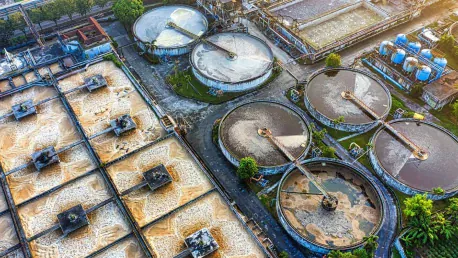In 2023, North Carolina’s water treatment plants achieved a remarkable milestone by setting new quality standards that surpassed both state and federal drinking water regulations. This achievement was recognized by the North Carolina Division of Water Resources, which honored 79 water treatment plants for their exceptional performance. Among these, 16 facilities received the prestigious “Gold Star” honor for maintaining high standards for ten or more consecutive years. This article delves into the factors contributing to this success and the broader implications for public health and environmental protection.
Recognition of Excellence
The N.C. Area Wide Optimization Award
The N.C. Area Wide Optimization Award is a prestigious recognition given to water treatment plants that exceed basic regulatory requirements. This award highlights the commitment of these facilities to achieving superior performance in water quality parameters, particularly in turbidity removal. Turbidity, a measure of water cloudiness caused by particles, is crucial as it can interfere with disinfection processes and harbor harmful microbes. This acknowledgment signifies that the honored plants have not only met but surpassed stringent performance goals, offering a safer supply of drinking water to their communities.
An essential element of the N.C. Area Wide Optimization Award is the evaluation of turbidity removal. This factor is critical as it directly influences the efficiency of disinfection procedures and microbial safety of the water. High turbidity levels can shield harmful contaminants from disinfection methods, increasing health risks. The award signifies a plant’s ability to manage and reduce turbidity to levels far below what is mandated by state and federal regulations. By doing so successfully, the facilities ensure their water treatment processes guarantee the highest degree of safety and cleanliness.
The “Gold Star” Honor
Among the 79 recognized facilities, 16 received the “Gold Star” honor, indicating their sustained excellence over a decade. Notable recipients include the Broad River Water Authority Water Treatment Plant, Cape Fear Public Utility Authority – Wilmington – Sweeney Water Treatment Plant, and the Cary/Apex Water Treatment Facility. These facilities have consistently maintained high standards, setting benchmarks for others to follow. The “Gold Star” honor serves not just as recognition but as an aspirational goal for other plants aiming to achieve long-term, sustainable quality results.
The facilities receiving the “Gold Star” honor represent the pinnacle of continuous excellence in water treatment. This accolade is reserved for those that have upheld the exacting standards of the N.C. Area Wide Optimization Award for ten or more consecutive years. This ongoing commitment is a testament to the facilities’ dedication to investing in training, resources, and technology that ensure superior water quality. Maintaining such standards over a decade illustrates that with concerted effort and innovation, high performance in water treatment is both achievable and sustainable.
Factors Contributing to Success
Advanced Water Treatment Techniques
One of the key factors behind the success of North Carolina’s water treatment plants is the adoption of advanced water treatment techniques. These techniques involve innovative approaches to removing contaminants and ensuring water safety. By leveraging cutting-edge technology, these facilities can achieve higher levels of water purity, thereby protecting public health. The use of novel filtration systems, chemical treatments, and automation has enabled these plants to operate more efficiently and effectively, thus setting new benchmarks in water quality.
The drive to adopt and implement advanced water treatment techniques has been instrumental in transforming the quality of drinking water across North Carolina. Facilities have increasingly integrated technologies that allow for better monitoring and control of water treatment processes. This includes real-time data analytics, predictive maintenance, and advanced membrane filtration systems that enhance the overall effectiveness of contaminant removal. By continually updating their methodologies in accordance with the latest scientific developments, these plants ensure that they remain at the forefront of water treatment technology, providing clean and safe water to the public.
Rigorous Adherence to Quality Standards
Another critical factor is the rigorous adherence to both state and federal quality standards. The recognized facilities have demonstrated a commitment to not just meeting but exceeding these standards, ensuring that the water supplied to the public is safe and free from harmful contaminants. This dedication to quality goes beyond compliance, embracing a proactive approach to continuously improve water treatment processes and outcomes. By maintaining stringent operational protocols and regular monitoring, these facilities make certain that their water treatment systems consistently deliver superior performance.
The commitment to adhering to elevated quality standards speaks volumes about the dedication of these water treatment facilities. Regular audits, staff training, and adherence to best practices are essential components of this commitment. The recognized plants not only align their operations with regulatory mandates but also pursue voluntary programs and certifications that push their performance standards even higher. This unwavering focus on quality assurance means that residents can trust that their drinking water meets the highest possible standards of safety and cleanliness, contributing significantly to the overall public health and well-being.
Impact on Public Health and Environmental Protection
Safeguarding Public Health
The superior performance of these water treatment plants has a direct impact on public health. By ensuring that water is free from harmful microbes and contaminants, these facilities play a crucial role in preventing waterborne diseases. The recognition by the North Carolina Division of Water Resources underscores the importance of maintaining high water quality standards for the well-being of the community. The measures taken by these plants, such as meticulous monitoring and advanced disinfection processes, significantly reduce the risk of outbreaks of water-related illnesses, thereby safeguarding the health of the population.
Waterborne diseases pose a significant risk to public health, but through rigorous water treatment processes, North Carolina’s recognized facilities provide a potent defense against these threats. By eliminating pathogens and harmful chemicals from the water supply, these plants ensure that the water reaching homes and businesses is safe for consumption. Public confidence in water safety is bolstered by the consistent recognition of these facilities for their excellence, reflecting a concerted effort to prioritize health outcomes through superior water quality management.
Environmental Protection
In addition to safeguarding public health, the recognized water treatment plants also contribute to environmental protection. By effectively removing contaminants from water, these facilities help preserve natural water bodies and ecosystems. This commitment to environmental stewardship is reflected in the widespread recognition of their efforts. Cleaner effluent from water treatment plants means reduced pollution in rivers, lakes, and streams, thus protecting aquatic life and promoting biodiversity.
Water treatment plants play a pivotal role in environmental conservation by ensuring that their discharge meets environmentally safe standards. The reduction of harmful pollutants like nitrates, phosphates, and heavy metals prevents the degradation of natural water sources. This, in turn, supports healthier ecosystems and contributes to the overall sustainability of local environments. The recognized facilities’ consistent performance aligns with broader environmental goals, showcasing how effective water treatment can harmonize public health priorities with environmental stewardship.
Geographic and Demographic Diversity
Urban and Rural Recognition
The award recipients span a diverse range of geographic locations, including urban cities, suburban regions, and rural communities. This geographic diversity demonstrates that high water quality standards are a priority across the state, regardless of the size or location of the community served. Facilities in large urban centers and smaller towns alike have been recognized for their exceptional performance. The wide distribution of these awards illustrates a statewide commitment to excellence, highlighting that all residents, regardless of where they live, have access to clean and safe drinking water.
Recognition of water treatment excellence across varied geographic locations underscores the universal importance ascribed to water quality throughout North Carolina. Urban water treatment facilities often face more significant demands due to higher population concentrations and industrial activities, while rural plants must tackle unique challenges such as limited resources and infrastructure. Despite these differences, the awarded facilities have uniformly excelled in meeting and exceeding stringent water quality standards, proving that location and community size do not constrain the ability to achieve superior water treatment outcomes.
Serving Different Population Sizes
The recognized facilities serve a wide range of population sizes, from large urban centers to smaller towns. This diversity highlights the universal importance of water quality and the ability of facilities of all sizes to achieve and maintain high standards. The commitment to excellence in water treatment is shared across different types of communities. Whether a facility serves a dense metropolitan area or a sparsely populated rural region, the principles of rigorous water treatment remain the same, ensuring that everyone has access to safe drinking water.
Serving a diverse array of communities demonstrates the adaptability and proficiency of North Carolina’s water treatment systems. Smaller towns, with limited financial and technical resources, are still able to achieve recognition through diligent efforts and innovative practices. Conversely, larger facilities managing more complex water systems have showcased their capability to maintain high water quality despite greater demand pressures. The consistent recognition of facilities of varying sizes and locales highlights a statewide culture of excellence in water treatment, benefiting millions of residents equally.
Sustained Excellence and Future Implications
Consecutive Annual Recognitions
Many of the recognized facilities have received consecutive annual recognitions, reinforcing the idea that excellence in water treatment is sustainable. By maintaining high standards year after year, these facilities set benchmarks for others to follow. This sustained excellence demonstrates that achieving superior water quality is not just an achievable goal but a long-term commitment. The annual recognitions serve as a constant reminder that continuous improvement and dedication are vital to maintaining high-performance levels in the water treatment industry.
The trend of consecutive annual recognitions among North Carolina’s water treatment plants underscores an enduring commitment to excellence. By regularly auditing and enhancing their processes, these facilities stay ahead of potential water treatment challenges, ensuring reliability and safety in their water supply. This ongoing acknowledgment from the N.C. Division of Water Resources highlights that consistency in water quality is not a one-time achievement but a continuous, evolving process that demands persistent effort and innovation.
Role Models for Other States
In 2023, water treatment plants in North Carolina accomplished a significant milestone by surpassing both state and federal drinking water quality standards. This remarkable achievement was recognized by the North Carolina Division of Water Resources, which celebrated the outstanding performance of 79 water treatment facilities. Notably, 16 of these plants earned the esteemed “Gold Star” honor for consistently maintaining high standards over a period of ten or more consecutive years. This recognition highlights the dedication and expertise of those working within the water treatment sector in the state.
This article explores the various factors that contributed to this success, including the implementation of advanced water treatment technologies, ongoing staff training, and stringent operational protocols. These measures collectively ensured the delivery of safe and clean drinking water to residents. Furthermore, this achievement underscores the broader implications for public health and environmental protection, signaling a positive trend towards sustainable water management practices that can serve as a model for other regions.









